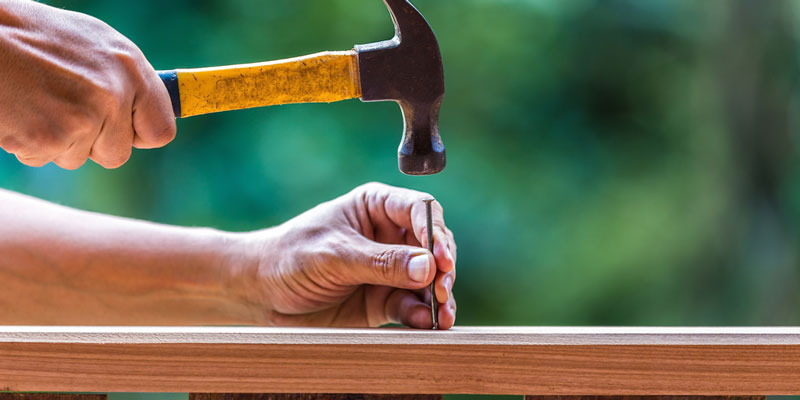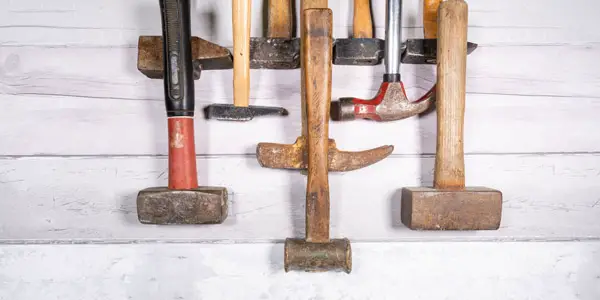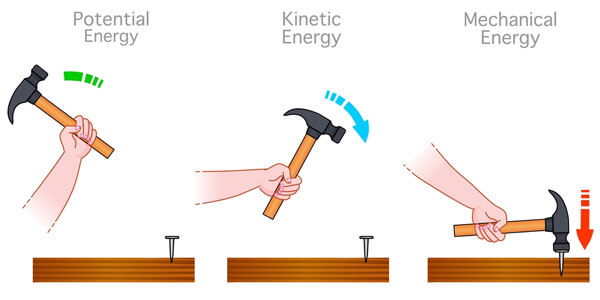Lots of DIY projects involve hammering. However, it usually puts you in a bad spot, and it easily becomes the bane of your neighbor’s life.

Stop the pounding…
Hammering a nail into a wall or while working on a project generates a loud noise.
Therefore, it’s commendable to consider your neighbors or family members by knowing when to hammer and how to do it quietly. Besides, you can explore other methods of driving nails into the wall or the project.
In this post, we’ll consider how to hammer quietly and alternative methods to achieve the same aim.
Types of Hammer
A laity will believe a hammer is a hammer.
I wish this were true; it’d make shopping for the right tool much easier and eliminate the mental challenge of choosing the right hammer for the project.

Sadly, they come in all sorts of designs, weights, shapes, and prices. Therefore, it’s easy to go wrong when shopping for a hammer, especially if you know little or nothing about this tool.
So, let’s take a quick overview of this extensive availability and understand the differences:
For most homes, the 16-ounce curved-claw hammer is a great choice; why? It offers incredible versatility to support a wide range of applications. This all-around tool is suitable for your protean projects. So, if you can only afford one hammer, it should be the 16-ounce curved claw hammer.
But if you prefer a lighter hammer for more control, you can opt for its little brother, a more lightweight model, the 13-ounce curved claw hammer. While the weight difference might seem small, the amount of control you can get from the slight weight difference is unbelievably remarkable.
Most home-based projects do not demand especially hammers like the heavy, ripping-claw framing hammer perfect for hammering concrete nails. They are more suitable for experienced DIYers or pro carpenters to handle demolition jobs or rough carpentry projects.
The standard claw shares a lot of physical attributes with the framing hammers. But they are not the same: the framing hammer’s longer hands and heavier head make all the difference. Keep in mind that this affects the noise level too. The heavier the hammer, the less control you might have, resulting in nut-driving noise.
This brings us to the million-dollar question: what’s the best hammer type for quiet hammering?
The Right Hammer for the Job
Choosing the right hammer significantly reduces the amount of noise you generate to annoy your neighbors or disturb your sleeping partner and kids. Your best bet against the pounding noise is a soft-faced hammer.
This option reduces the impact force on the nails to allow DIYers to drive the nails into the wall or project softly and quietly. Also, a rubber mallet can do the trick well, and it delivers a soft blow for a nearly noise-free hammering. However, you want to ensure the nail’s head is broad to prevent your hammer from shattering.
This option allows you to hammer without being the bane in someone’s life. But, it would be best if you made sure no gaps exist between the wooden surface and the nail heads for a quiet hammering experience. You might want to switch your nails to glue sticks to solve this issue. This way, you only need a fraction of the effort for nearly the same result.
Get Your Hammering Technique Right
If your neighbor comes knocking on your front door because of the pounding noise from your hammering, it’s likely because you kept hitting the nail hard. It’s a simple principle, the harder you hit, the louder the pounding noise.

Hammering doesn’t have to disturb the peace and quiet of other people if you keep striking the nail softly. So, if you don’t want to drive your neighbors nuts, you should gently tap on the nail. Although this method will take longer to drive a nail into a wall or wood, you will do this without the loud noise.
Also, taking your time to tap the nails gently might seem like a time waste, considering it takes longer to nail. However, it reduces the noise level significantly, but it also lessens your chances of breaking or splitting the nails.
The secret to hammering quietly is to be patient and land slow blows!
Materials For Dampening the Noise
Rubber Bench Block
This block is not designed for hammering but with metalsmiths, silversmiths, and watermakers in mind. However, it can help manage this situation.
Place the rubber bench block between the head of the nail and your hammer to minimize the noise when driving nails into wood or a wall. The block is made of rubber with a dense, thick, and elastic property for reducing impact vibration. Therefore, it helps dampen the vibration energy from striking a nail with your hammer.
If you’ll be driving a lot of nails and you don’t have the patience to do it slowly, the rubber bench block might be your best bet,
Cloth/Soft Material
Not everyone can easily lay their hands on a rubber bench block, but you don’t have to beat yourself up about the unavailability. You can use your old clothes instead. When striking, place the old T-shirt between the nail head and hammer-like the rubber block bench.
You might want to increase the number of clothes between the hammer and nail head for quiet hammering. However, with more clothes, you will have to land stronger blows to drive the nails all the way in.
The downside to this method is that it can be tiring if you’ve to hammer many nails.
However, you can get creative since you understand the underlying principle of dampening the impact vibration. To make your job easier, you can wrap the hammerhead or attach thick clothes in several layers. There is no one way to do this, per se. The simple idea is placing thick clothes between the nail’s head and hammer; it’s up to you to choose how you want to go about this.
More importantly, you don’t want to use light fabrics 一 it’s a waste of time and not as effective as thick cotton fabrics. Stay away from polyester or silk materials!
Rubber Floor Mat
Rubber Floor Mat inhibits the migration of the vibration from your working on a bench from traveling through the floor, and it reduces the noise significantly when used with other techniques discussed in this post.
Like the rubber block mat, this mat absorbs vibrations to minimize the noise from the striking nails. The downside to this option is that you always reposition the rubber floor mat as you move the bench around your workshop.
Another way to do this is to place a rug or a few towels on the floor to muffle the noise when hammering. Either rubber floor mats or rugs should not require you to break the bank. Plus, it helps soundproof your workspace since it helps prevent vibration from the impact from bouncing off the hard floor, which amplifies the noise.
Location
Location is another important thing to consider when trying to drive nails into an object using a hammer. Doing this in the confines of your room or tiny space produces a louder pounding noise compared to hammering in an open space or outdoors. So, if you don’t want to be a disturbance, take your project outside (if you can).
Time
Sometimes, it’s your timing at fault. You should know when you can make noise without disturbing your neighbor. For instance, you can schedule your DIY project or nailing when your neighbors or partner go shopping, attend a church service, or have fun outdoors.
It’s wrong and inconsiderate to hammer when in the early or late hours of the day when it’s quiet out there, and everyone is trying to enjoy the peace and quiet of the day.
Related FAQs: Hammer Quietly
Rubber mallets or dead blow hammers are ideal as they produce minimal noise compared to traditional metal hammers.
Yes, you can place a soft cloth between the hammer head and the object being hammered to muffle the sound.
Quiet hammering techniques are especially useful for home improvement tasks in shared living spaces or during late hours when minimizing disturbance is essential.
Conclusion
Many jobs requiring nailing can be done with screws. While this might take longer than nailing, it’s quieter and great for projects demanding a couple of screws.
It’s a great alternative but won’t work in all cases. So, if you find yourself on the other side – hammering – you should consider some of the tips and tricks shared in this post. The more options you use at a time, the quieter you can nail your project.
Furthermore, it’s not a bad idea to soundproof your workshop if you plan on hammering regularly. This way, you can use any type of hammer and work at any time of the day without worrying about your family member or easily irritated neighbor.
